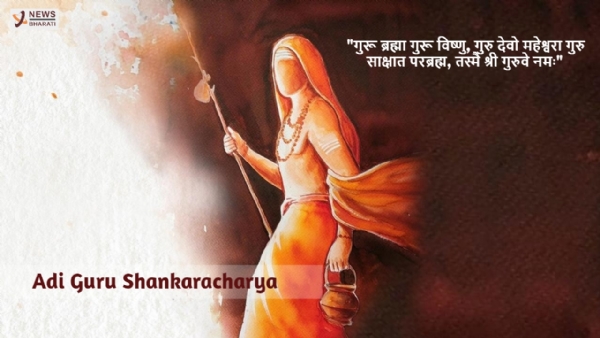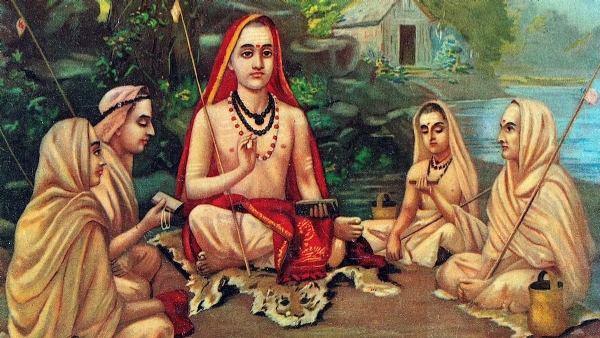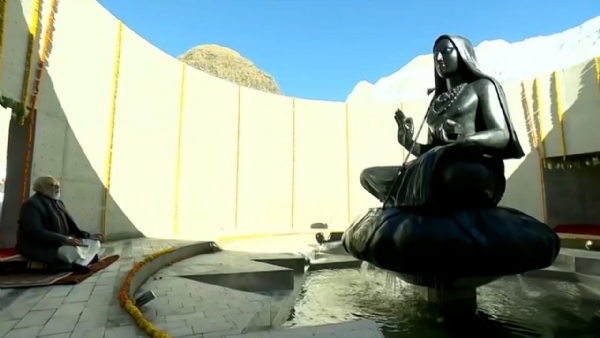Greatest of the great: Adi Guru Shankaracharya
Shloka that is written by Adi Shankaracharya explains the importance of Guru in one"s life. Shankaracharya says, "One"s body and one"s wife may be beautiful; one may have fame, love, excellence, and wealth equal to that of Mount Meru (which is said to be made of pure gold), but if one"s mind is not attached to the lotus feet of the Guru, what then, what then, what then, what then?"
Total Views |
शरीरं सुरूपं तथा वा कलत्रं
यशश्चारु चित्रं धनं मेरुतुल्यम् |
मनश्चेन्न लग्नं गुरोर गुरोरङ्घ्रिपद्मे
तत: किं तत: किं तत: किं तत: किम् ||
The above mentioned shloka that is written by Adi Shankaracharya explains the importance of Guru in one's life. Shankaracharya says, "One's body and one's wife may be beautiful; one may have fame, love, excellence, and wealth equal to that of Mount Meru (which is said to be made of pure gold), but if one's mind is not attached to the lotus feet of the Guru, what then, what then, what then, what then?"

The Bhagwad Gita, in 34th verse of Chapter 4 talks about Guru, and reads, “Understand this; By surrender (of self-will) to the Guru, by (sensitive inward and outward) questioning (of the Guru), and by service (to the Guru), those (sages and Gurus) who have realized the truth will (be able to) convey their wisdom to you.”
तद्विद्धि प्रणिपातेन परिप्रश्नेन सेवया |
उपदेक्ष्यन्ति ते ज्ञानं ज्ञानिनस्तत्त्वदर्शिन: || 34||
It is clear, from the available literature that according to the Hindu dharma, to role of Guru in the society was not only important spiritually but also scientifically, socially, philosophically and more importantly, personally, for an individual. Hindu Dharma has witnessed the legacies of several great Gurus and one of them stands to be the greatest of the great Gurus; Guru Adi Shankaracharya. The contribution of Adi Shankaracharya in planting and enhancing the sapling of Hindu dharma and transform it into a huge tree is pivotal.
Dr. Surendra Pathak, a Professor in IASE Rajasthan, in his paper titled 'Adi Shankaracharya: Contributions and influences on Sanatana Dharma and India culture' mentions him as 'the earliest religious reformer' and says, "Adi Shankaracharya, one of the most important philosophers and religious leaders in Indian history and the Hindu Sanatan religion, is widely revered as a religious reformer, the formulator and codifier of the Advaita Vedanta philosophy, the non-dualistic system based upon the Upanishads."

Ever since his childhood, Shankara showed a liking towards spiritual knowledge. He was capable to easily recite the Puranas and the Epics. Shankara mastered the Vedas during his early years at the Gurukul.
Pathak further describes, "Shankara is the foremost among the master-minds and the giant souls which Mother India has produced. He was the expounder of the Advaita philosophy. Shankara was a giant metaphysician, a practical philosopher, an infallible logician, a dynamic personality and a stupendous moral and spiritual force. His grasping and elucidating powers knew no bounds. He was a fully developed Yogi, Jnani and Bhakta. He was a Karma Yogi of no mean order. He was a powerful magnet. His contributions are enormous for the India."
According to Swami Bhajananda, "Advaita Vedanta is the most dominant and most well-known school of Indian philosophy. Among the several philosophical schools (darshanas) of Vedanta, Advaita occupies the pinnacle of the pyramid formed out of all the darshanas. Vedanta, is not mere view of reality, it is also a way of life. Its aim is to enable human beings to solve the existential problems of life, transcend human limitations, go beyond suffering and attain supreme fulfillment and peace."
Also read: Ancient events that took place on the day of Guru Purnima
Swamiji says, "Of the different schools of Vedanta, Advaita for its domain the mainstream Hinduism, whereas the other schools of Vedanta are associated with the different sects of Hinduism. It is well known that the edifice of Advaita philosophy, which towers over all other systems of philosophy, was built by Acharya Shankara in the eighth century." 'Advaita' propagated the monoistic aspect of darshana; whereby 'Brahman' is considered as the sole reality. It means that individual selves are either real or illusionary distinctions within Brahman.
In even easier words, may it be a dualistic (Dvaita) darshana or non - dualistic (Advaita) darshana, all Vedanta schools believe that 'Brahman' is te ultimate reality. The only difference between the two is that Dvaita schools believe that individual self and supreme self are two different identities, however, on the contrary Advaita darshana identifies both individual self and supreme self as the same, just their forms are different.
Shankaracharya describes the same phenomena by saying, "What is called jiva is not absolutely different from Brahman. Brahman itself, being conditioned by adjuncts such as buddhi, intellect and the like comes to be called 'doer' or 'experiencer'." Shankaracharya's foremost contribution to Indian philosophy and society is the significance associated with one's inner self to comprehend reality, and then further developing the same method from individual to group level. He thus laid the foundation, of a conscious Indian society.
I'm sure you didn't know about this place associated with Adi Shankaracharya..

It is sad that although so many people visit the ancient Kedarnath temple in Uttarakhand annually, not as many people know that the samadhi of Adi Shankaracharya, who built the grand temple, is situated exactly behind the temple.
Slightly behind the Kedarnath Temple is the samadhi of Adi guru Shankaracharya, the saint who established the sacred Char Dhams in India that are an important pilgrimage for Hindus. Adi Shankaracharya attained nirvana (enlightenment) at a young age of 32. It is said that Shakaracharya merged with the land itself.
According to the legend, Shankaracharya came to Kedarnath in the 8th century and built the Kedarnath shrine and established one of his four mathas. A hot water spring believed to have been created by Shankaracharya is visited by his disciples to get relief from the extreme climatic conditions in the area.
Recently, in Nov 2021, Prime Minister Narendra Modi inaugurated the reconstructed Shri Adi Shankaracharya Samadhi at the premises of the Kedarnath Temple in Uttarakhand and unveiled the statue of Shri Adi Shankaracharya at the Samadhi. The Indian govt reconstructed the samadhi that was damaged in the 2013 Kedarnath flood.


